Wendy Murray Zoba
The Voice That Found Her
Native American novelist and poet Diane Glancy writes by listening.Books by Diane Glancy mentioned in this essay:
Claiming Breath (Univ. of Nebraska Press, 1992).
The Closets of Heaven (Chax Press, 1999).
The Cold-and-Hunger Dance (Univ. of Nebraska Press, 1998).
Flutie (Moyer Bell, 1998).
Fuller Man (Moyer Bell, 1999).
The Only Piece of Furniture in the House (Moyer Bell, 1996).
Pushing the Bear (Harcourt, 1996).
The West Pole (Univ. of Minnesota Press, 1997).
She would say that you start with nothing. Then you poke a hole in it and step inside. Then it becomes something. That is where you begin.
In high school she stood in front of a class and refused to speak. It wasn't because she didn't have anything to say. Voices inside her were clamoring to get out. But that classroom was not the place. The teacher threatened to fail her.
She is Diane Glancy, novelist, essayist, playwright, and poet, the daughter of a Cherokee father and a mother whose ancestors were German. She grew up in the white world, but could not assuage the voices of her Native American heritage. At the same time she heard the voice of her stern, goal-oriented German heritage, mainly expressed through her mother. Later there would be the voice of the academician and her Christian voice.
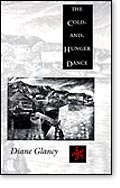
The Cold-and-Hunger Dance
"I can tell several stories at once," she writes in The Cold-and-Hunger Dance. "Mixed-blood stories of academic life and the experience of Christianity. Nothing fitting with anything else. The word community has always meant being left out." Being a woman didn't help.
She eventually found the one voice that held the others together. Or the voice found her. It came through her writing. The result has been a body of work that defies literary conventions. Critics and marketers prefer writers who are easily categorized. This one is a Novelist, that one a Poet. Glancy not only writes in every familiar genre, she also crosses genres—mixing prose and poetry in the same book, for instance. She's Native American—but unlike many high-profile Native writers, she's also strongly Christian.
If she is hard to categorize, she has nevertheless found readers. Her work has earned her, among other prizes, an American Book Award, a Pushcart Award, and a North American Indian Prose Award. She has received grants from the National Endowment for the Arts and the National Endowment for the Humanities. She has likewise built an academic career; as an associate professor at Macalester College in St. Paul, Minnesota, she teaches creative writing and Native American literature. She is poet laureate of the Five Civilized Tribes. She attends a Bible-believing born-again spirit-filled fundamentalist church.
"The Native believes that the voice is spiritual," she told me when we met in her office last fall. "What you speak actually makes things happen. You tell a story and you empower somebody with knowledge," she says, which might explain in part why she refused to speak that day in her high school classroom. "I had a voice. It carried the pain of my grandmother and father's side, the Cherokee side, the Trail of Tears, the heaviness, the grief, the loss, the disrespect. It was a burden that was there in the voice."
But that was only part of the reason for her self-imposed silence. She also felt the force of her mother's "determined with-it voice," as she calls it. "What are these words I dislike so much? Organization. Goals. Determination. Getting things done. I had two voices and they clashed. I had that storm within me and I was not willing to expose it before everyone. I refused to speak. It was a power I had."
Glancy's father, Lewis Hall, left his Cherokee heritage to assume the life of the white man. He grew up in Arkansas with his mother and sister. During the Depression, he moved to Kansas City to look for work and ended up in the stockyards, where he did well and moved up. Glancy remembers some of the first words he spoke to her: "We're going to live in this world. It's not a bad world."
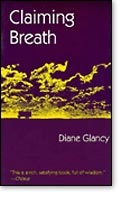
Claiming Breath
As she writes in Claiming Breath, a genre-crossing book of short prose pieces with a flavor of poetry:
He left his heritage to follow this world & I remember the vacuum it made in him. Our heritage doesn't die—It leaves an open gash in need of stitches. Riding in the back seat of our '49 Ford, I watched his black hair—his hands on the wheel. I remember feeling the universe there with us—& at the same time, I remember the hole in our heads where our heritage had once been.
Glancy herself was born dark, like her father. Her mother's people were blond and blue-eyed. "I was a stranger in that group," she says. Her mother, Edith Wood Hall, eschewed the Native heritage of her husband, and her daughter's dark skin strained their relationship. Nor could her mother understand the young girl's mystical inclinations—hearing the voices of her Cherokee ancestors.
At school the young Glancy felt doubly disenfranchised. When she and her classmates studied the Indians they made teepees and feathered war bonnets. But, Indian though she was, she had never seen a war bonnet. And the Cherokee hadn't lived in teepees. They were farmers, not migratory like the Plains Indians. She was Indian in a white culture and a Cherokee in Plains Indian territory. "We were Indian, but not the kind that hunted buffalo."
Her first dynamic encounter with Christianity came as a young girl, when she visited a vbs program sponsored by a local Baptist church. The teacher showed the class a picture of Jesus holding a black sheep. The little Indian girl understood that picture meant that Jesus loved everybody, even the dark ones.
She graduated from high school in 1959 and entered the University of Missouri the following fall. She finished her undergraduate studies five years later, in 1964, the same year she got married in defiance of all the voices.
The next 19 years were a crucible of struggle. Her husband, an Irishman, succumbed to alcoholism and Glancy was left to raise her two children on her own. Her marriage was like "trying to drive a loaded 18-wheeler up a sandy incline," she writes in The Cold-and-Hunger Dance. "There was a voice saying, 'hold on, it will connect and go somewhere.'" The voices found release during those hard years. That was when she started writing.
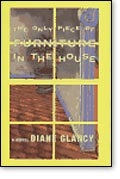
The Only Piece of Furniture in the House
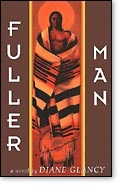
Fuller Man
The two novels she wrote during her marriage, The Only Piece of Furniture in the House and Fuller Man, were both rejected by publishers and filed away. (It would be 25 years before they would see the light of day.) Also during that time she completed a collection of short stories and finished her master's degree at Central Oklahoma University in 1983. Her marriage ended that year. "We were in Oklahoma when we divorced and I left him without any money. I had two children. I had nothing."
She had been working for the State Arts Council of Oklahoma, living hand-to-mouth, for several years when she met poet Gerald Stern at a writer's conference. He helped her get an Equal Opportunity Fellowship to attend the University of Iowa's Writer's Workshop, from which she received her MFA in 1988. That year Macalester College called her and asked her to join their faculty. She has been there ever since.
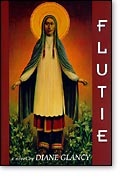
Flutie
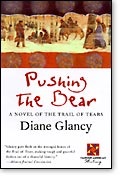
Pushing the Bear
Voices, lost and recovered, give life to the three books closest to Glancy's heart: Flutie, Pushing the Bear, and The Closets of Heaven. Thirteen-year-old Flutie Moses, half-white, half-Indian, feels trapped in her provincial, dysfunctional, and seemingly interminable existence in rural Oklahoma. She can't speak to strangers or in public. Her older brother Franklin ends up in jail for stealing car parts (even from his father); her white mother vents her despair over a stifling marriage by putting the pedal to the metal on the back roads of Oklahoma (for which she also does jail time); and her father, a mechanic and a Cherokee, is like a ghost who has lost his story.
The Oklahoma landscape is more than the setting of the book. It assumes a role, like one of the characters. Flutie is driving with her father and brother on a long-coveted road trip to the Salt Plains:
They passed the glass mountains and red mesas. Here were the voicings, Flutie thought, the tongues of the land, speaking in short bursts of courage before the wind blew the words back into their mouths. Her eyes throbbed. The birds rising on air currents above the bluffs were the words that the land said.
Flutie longs to hear stories from her father about his Native heritage, but he refuses. Her disconsolate mother, on the other hand, is never at a loss for words: "Her mother shot words that hit her." The physical and emotional austerity of Flutie's childhood, along with her mixed heritage and her paralyzing shyness, causes her to retreat into a world of visions and fantasies:
Sometimes in the darkness inside her head, she could see an opening above her. She could see figures looking down at her from the opening. They were Elders. Helpers. She knew it. Maybe they were the Indian people of her father's tribe who were gone, but they were still there.
At 15, Flutie still has not overcome her demons. "Open my mouth that I might speak. That was what she wanted each year in school. Release." At 17 she turns to drugs and alcohol to find it. "She had a voice somewhere inside her. She could feel it moving."
When she refuses to marry her high-school boyfriend, her mother kicks her out of the house. She takes a loan to attend college and leaves for the city: "Flutie drove the truck and cried as she drove … She had to speak a road into being, but the words would not come. Maybe someday they would."
Flutie finally finds her voice one day in a college classroom:
It was Flutie's turn to work through an algebra problem on the board. In speaking, Flutie felt the storm hit. The water pounded her head. She felt her unsteady knees . …
The Great Spirit reached down and poked her throat open and let out the lava. She was in the power of her voice. She spoke the boiling words. Her whole being rocked. Her head spasmed. She sat down. The room shook with her. But it was done. … She traveled in her head all that day. She would speak in the next class and the next. Tongues would fill her mouth. Soon she wouldn't be able to wait for her turn.
Where Flutie gives voice to an individual consciousness, unforgettably distinct, Pushing the Bear gives voice to an entire community, the Cherokees who walked the Trail of Tears in 1838-39. Glancy describes this communal storytelling in The Cold-and-Hunger Dance:
Native American storying is an act of gathering many voices to tell a story in many different ways. One voice alone is not enough because we are what we are in relationship to others, and we each have our different way of seeing. Native American writing is also an alignment of voices so the story comes through.
Pushing the Bear "stories" the Trail of Tears through a multitude of narrators, some historical, others fictional.
The book opens with an epigraph that reads: "From October 1838 through February 1839 some eleven to thirteen thousand Cherokee walked nine hundred miles in bitter cold from the southeast to Indian Territory. One fourth died or disappeared along the way." The parents of Glancy's great-grandfather, Woods Lewis (born in 1843), were numbered among those who walked the Trail.
Her inspiration came in the late 1970s when she saw a dramatization of the Trail in Tahlequah, Oklahoma. In the mid-1980s she traveled to New Echota, Georgia, where the Treaty of New Echota was signed by a few Cherokee relinquishing the eastern lands of them all. "When you write as a Native writer you've got to be on the land because the land is the first thing that speaks," she says. Glancy was on the grounds of New Echota when she heard the voice of the novel's main character, Maritole: "I knew she was sitting on her cabin steps. I knew she looked over the dried corn stalks and I knew there was a cloud of dust and the soldiers were coming."
It took Glancy nearly 20 years to complete this book, partly because her Cherokee kinsmen did not want her to write it. "They said, 'Don't write that book. Speaking brings it back into being. We don't want to hear that.'" Beyond that, the historical record was skimpy. "Not a lot was written about it or left behind because the Indians were ashamed of it and the government was ashamed."
There were stretches when she would put her research away and work on other projects. In time, however, "those voices would begin to rumble around. They wanted to be told and I knew they did." So she pressed on. Her research included traveling the same 900-mile trek that her ancestors had walked.
An important subtext of the book is Glancy's examination of the role of Christianity in the lives of the Cherokee and—in view of their tortured circumstances on the Trail—their treatment at the hands of the Christian white man. The many narrators represent varying degrees of belief or unbelief, both in the Christian God and the traditional gods of the Cherokee.
Maritole's father has lost hope in the power of the tribal magic: "I had made a trap to protect our cabin. I removed the brain of a yellow mockingbird. … put it into a hollowed gourd, buried it in front of the door. But the soldiers came anyway. Now we are walking."
The Reverend Jesse Bushyhead, a Native half-breed and an historical figure, preached a sermon about halfway along the Trail:
"I hear the spirits with us. We are not abandoned. At night I hear the angels groaning under the weight of their wings. We can't see them—no—" I shook my head. "They're rolling our wagons on the long path to the new territory. We're wheezing and jerking and spilling our way. … Does not our blood stain the snow?" My voice cracked. Not since the smallpox epidemics had so many died. Even the animals dragging the wagons collapsed . …
"We look at our sorrow and know it's not all," I reminded. "Somewhere people are warm and singing in their churches. We will again. Our children. Some will survive. We are the land. We'll have a remnant—We'll—" I coughed back my grief and began at another place. "Our journey—the one ahead—the one after this walking—will begin again from nothing. This is how we go. Always back to nothing." I stumbled as if my words were a bundle I carried. As if I were top-heavy with my sermon.
And Maritole's broken and despairing husband, Knobowtee, reflects near the trail's end:
There was a voice somewhere. With all the voices on the trail. Ancestors. Conjurers. People. Even the voices of the animals and the land. I was almost sure I heard a voice. You brought us through the fire and through the water—Maybe it was Bushyhead preaching in his sleep. … Maybe it was a voice beyond hope. A certainty I could hear in the ministers' voices. It woke me in the night. There was something that made sense. I just couldn't see it. But look at the churches in the towns we passed. It was their God. Those people who made the Cherokee walk.
The tug of war in this book over matters of faith reflects Glancy's own struggle in trying to reconcile her Native heritage with her Christian beliefs. "It is a hard lump to swallow, the enemy bringing this message," she says. "I hear [the Cherokee] say all the time, 'They stole our land. They stole our culture,' and it's true." Still, she says, "The white culture brought Christ, and that is one thing the Native Americans would never have known. Many Natives don't want to hear it. They want to follow their own way and do things in their own strength." She writes in Claiming Breath:
I think the sacred hoop of the Indian nation was broken because it wasn't the sacred hoop of God. It wasn't complete. It left too much to pride & self works. … & the incompleteness of the sacred hoop before God was made evident. & it was broken by the white man with his terrible ways. His repeating rifles & broken treaties & all the treachery that is in the human heart.
Yet in that imperfect vehicle came news of the light. That is a hard lesson.

The West Pole
She has reconciled these voices through her writing. For example, in The West Pole, she likens the Christian faith to the Native understanding of the horse:
When the Native American saw the horse he called it Sacred Dog. Or the Medicine Dog. It came to define wholeness for the Native American. When two-rode-as-one. Or when the horse's shadow and your shadow were one. That's what it feels like to receive the light of Christ and ride on in faith.
She returned to the Cherokee people once Pushing the Bear was complete to do a reading. It was the hardest reading she has given, she says. "They don't give you much recognition by voice. But they sat there nodding. It was accepted very well."
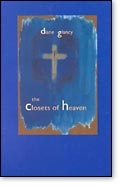
The Closets of Heaven
To give voice to her ancestors who walked the Trail, Glancy had to listen across the span of two centuries. In The Closets of Heaven, she is even more audacious. Here she goes back 2000 years to recover the voice of the biblical character Dorcas (Acts 9:36-43), the voice of one called back from death to life.
Dorcas confesses early in the book, "Sewing is my prayer." She is confused by talk among her fellow Christians about being saved by faith alone:
By faith I am saved. By faith. That's what they say Peter preaches. But salvation is also by works. That's what I want. When I sew, the power of God is undeniable. I feel my thoughts as I sit in the dark. I have purpose. I have something to do.
As she ponders these things, she feels a dull pain that eventually becomes acute to the point of death. Then Dorcas enters heaven:
I see there are closets in heaven. Full of shawls and mantles. … I see the transformation of cloth. The resurrection of sewing. … Beyond the closets, I see a vast city of people. Streets. A river. Somewhere a throne. I see heaven full of flying beings. Birds. Crowned pigeons. Their eyes red as heaven. … Closets of garments I have sewn. I cannot explain. I wish I had used more than one thread on a needle. Threads of different colors. Why didn't I know?. … I want to rework all I have sewed. I see the garments differently now; I see them as garments within garments.
She hears her name—not in its Greek form, Dorcas, but rather in Aramaic, her mother-tongue: Tabitha. "I open my eyes and see the disciple. I know he is Peter. The power of his word pulls me. I am on the shores of heaven when I hear his voice. … Peter has my hand; I draw it back. I want to snip off his arm, but I remember I must be polite."
She spends the rest of her resurrected days enduring the questions of fellow widows. What was it like to die? What is heaven like? Why can't you describe it better?
I want to cry, but I will not let the tears run down my face. We don't always get to do what we want, I tell myself. But I am angry. The first time I was going someplace, I was returned to Joppa. … How dare Peter bring me back? How dare the other widows ask him to call me? I was in heaven. … Why couldn't they leave me alone?. … What do I do now? Tolerate these women? Wait for another death?. … Whose idea was it?
Like most of the principal characters in Glancy's fiction, Dorcas is an ordinary woman. "I speak ordinary things into being, like the common woman with an ordinary life," Glancy says. "I wasn't a king. I had not gone to war. I was a woman without much of a voice. I was nothing. But I would make something of the nothing."
Language is Glancy's tool for building something out of that nothing. She stretches it, she says in The Cold-and-Hunger Dance, to accommodate the voices of minorities and women. The Native voice expresses itself in rhythms and cadence. Her use of imagery borders on mystical. One reviewer said Flutie reads almost like a myth. A reader told me that her books ought to be sung.
Women's voices, Glancy says, are often not "strong and forward moving," so she accommodates that with a meandering style. She makes no apologies for inordinate use of the passive voice. "It is circular, indirect, fluid, dreamlike, and intuitive. It speaks from the heart. It is the holding together of language in your own original expression," she says.
But the story is a force beyond the words themselves that exists in its own right. She hears it, gives it form through language, and it thus imbues the reader or hearer with its power: "It is the spirit of storytelling, rather than the artifact of the story itself, that goes forth. It's an energy field that generates power and does not die." She likens it to God, who, independent of the physical expressions of his world, can say, "I am that I am."
Having found her voice, Glancy doesn't take it for granted. She is working on three new novels. One is a "white novel" about an older woman whose husband has Alzheimer's. Another is a Native novel, with the working title Designs of the Night Sky, in which she uses a creation story to animate the origins of written language: "The Native believes the voice is spiritual and the written word has killed the voice, nailing it on the page. This book is a story of the written word moving around in the night sky like the constellations, and how it is important too." Finally, she is at work on another fictional biblical narrative, inspired by the account of the four daughters of Philip who prophesied (Acts 21:9). "Their names are not given. What were those four women like?"
To claim breath, to find one's own voice, Glancy teaches us, requires attentiveness to the voices of others. She's listening.
Wendy Murray Zoba is a senior writer for Christianity Today and the author most recently of Day of Reckoning: Columbine and the Search for America's Soul (Brazos Press).
NOTE: For your convenience, the following books, which were mentioned above, are available for purchase:
• Claiming Breath, by Diane Glancy
• The Closets of Heaven, by Diane Glancy
• The Cold-and-Hunger Dance, by Diane Glancy
• Flutie, by Diane Glancy
• Fuller Man, by Diane Glancy
• The Only Piece of Furniture in the House, by Diane Glancy
• Pushing the Bear, by Diane Glancy
• The West Pole, by Diane Glancy
Copyright © 2001 by the author or Christianity Today/Books & Culture Magazine.
Click here for reprint information on Books & Culture.








Displaying 0–0 of 0 comments.
Displaying 0–0 of 0 comments.
*